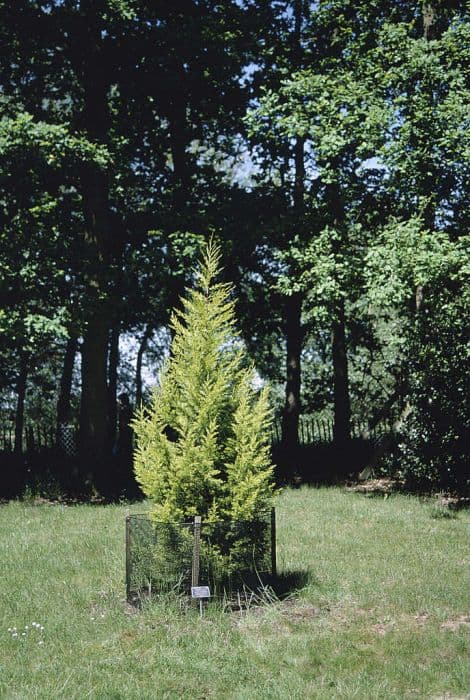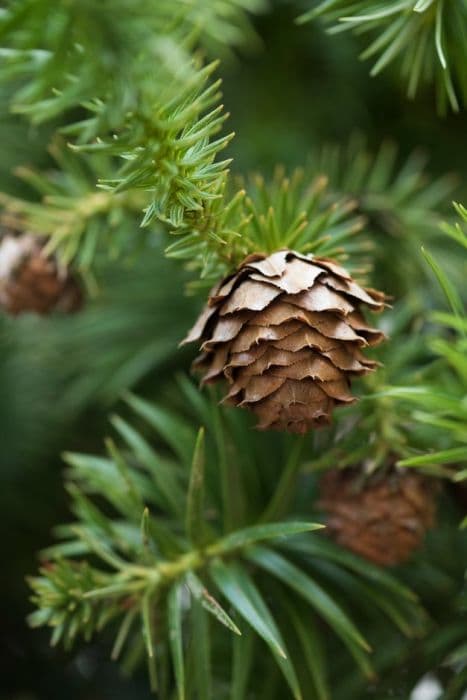Pfitzer Juniper Juniperus × pfitzeriana 'Sulphur Spray'

ABOUT
The 'Sulphur Spray' is a variety of the plant commonly known as Pfitzer Juniper. It has a distinctive foliage that sets it apart from other junipers. The foliage is fine-textured and features a mix of colors that resemble a dusting of sulfur. The needles have a soft appearance and are typically a bright yellow-green hue, giving the plant a colorful spray effect, especially in the new growth. As the needles mature, they may take on a more muted green color, but the striking yellow tones often remain, particularly when exposed to full sun. This coloration makes the 'Sulphur Spray' a vibrant choice for landscapes, providing year-round interest with its evergreen foliage. The branches spread outward in a graceful, arching manner, giving the plant a lush and somewhat feathery look. This selection of juniper is often prized for its aesthetic quality and its ability to add a splash of light color to garden settings.
About this plant
 Names
NamesSynonyms
Pfitzer Juniper, Pfitzer's Juniper
Common names
Juniperus × pfitzeriana 'Sulphur Spray'.
 Toxicity
ToxicityTo humans
The Pfitzer juniper is not commonly known to be toxic to humans. However, as with many plants, individual components such as the needles or berries may cause mild stomach upset if ingested in large quantities due to non-toxic irritants. Consuming parts of this plant is not advised, but accidental ingestion typically does not result in severe poisoning or long-term consequences.
To pets
The Pfitzer juniper is also not commonly known to be toxic to pets. Similar to humans, the ingestion of plant parts like needles or berries may cause mild gastrointestinal upset in some animals, particularly if consumed in large amounts. While it's generally best to prevent your pets from eating plants, ingestion of this juniper usually does not lead to severe poisoning or serious health issues.
 Characteristics
CharacteristicsLife cycle
Perennials
Foliage type
Evergreen
Color of leaves
Blue-green
Height
3-4 feet (0.9-1.2 meters)
Spread
4-6 feet (1.2-1.8 meters)
Plant type
Shrub
Hardiness zones
4-9
Native area
Cultivar
Benefits
 General Benefits
General Benefits- Drought Resistance: Once established, 'Sulphur Spray' can withstand periods of low water availability.
- Low Maintenance: This plant requires minimal care once established, making it ideal for gardeners looking for low-maintenance options.
- Erosion Control: Its root system helps stabilize soil on slopes, preventing erosion.
- Year-Round Interest: The distinct foliage color provides visual interest in the landscape throughout the year.
- Habitat Support: Provides cover and nesting sites for birds and small wildlife.
- Adaptability: Can adapt to a wide range of soil types, from sandy to clay, as long as the site is well-drained.
- Cold Hardy: This juniper variety is tolerant of cold temperatures, making it suitable for gardens in cooler climates.
- Decorative Use: Ideal for rock gardens, foundation plantings, and as a ground cover due to its spreading habit and unique foliage.
 Medical Properties
Medical PropertiesThis plant is not used for medical purposes.
 Air-purifying Qualities
Air-purifying QualitiesThis plant is not specifically known for air purifying qualities.
 Other Uses
Other Uses- Photography Backdrops: 'Sulphur Spray' Junipers can provide a textured and colorful background for outdoor portrait photography.
- Bonsai: Due to its aesthetic branches and foliage, it can be trained to grow as bonsai, offering a unique hobby for gardening enthusiasts.
- Erosion Control: Their root systems help stabilize slopes and prevent soil erosion in landscaping.
- Noise Reduction: When planted in rows, these dense shrubs can act as sound barriers to reduce traffic or neighborhood noise.
- Windbreaks: 'Sulphur Spray' can be used as windbreaks to protect gardens and homes from strong winds.
- Culinary Garnish: Though not commonly consumed, fresh sprigs can be used to garnish plates or platters for rustic presentations.
- Theater and Film: Works as a prop to simulate other evergreen plants in set design, especially when specific plants are not readily available.
- Privacy Screening: Its thick foliage provides a natural visual barrier for privacy in residential landscaping.
- Artistic Inspiration: Artists may use the form and color of 'Sulphur Spray' Junipers as subjects or inspiration in their landscape paintings.
- Winter Gardens: They retain their foliage and color even in winter, providing interest in otherwise barren landscapes.
Interesting Facts
 Feng Shui
Feng ShuiThe Pfitzer Juniper is not used in Feng Shui practice.
 Zodiac Sign Compitability
Zodiac Sign CompitabilityThe Pfitzer Juniper is not used in astrology practice.
 Plant Symbolism
Plant Symbolism- Protection: Juniper plants, in general, are often associated with protection due to their prickly nature, which historically was believed to ward off negative influences and malevolent spirits.
- Purity: Juniper has also been used for cleansing and purifying, as its smoke was used in various rituals to purify the air and the environment, symbolically cleansing spaces from negative energy.
- Healing: Owing to its antiseptic properties, juniper has had a longstanding association with healing. Various parts of the juniper plant have been used in traditional medicine, symbolizing health and recuperation.
- Longevity: Being an evergreen plant, juniper often symbolizes eternal life and youth, as it maintains its green needles throughout the year.
 Water
WaterPfitzer Juniper prefers even moisture but well-drained soil. It should be watered thoroughly whenever the top couple inches of soil feel dry to the touch. Generally, this might mean watering once every week or two, depending on climate conditions, with more frequent watering necessary in hot, dry periods. It's essential to avoid overwatering, as Pfitzer Juniper is sensitive to root rot. Aim for about 1 to 1.5 gallons per watering session, but adjust the amount based on rainfall and temperature conditions to ensure the soil remains moist but not soggy.
 Light
LightPfitzer Juniper thrives in full sun conditions, which means it should receive at least 6 hours of direct sunlight daily. The ideal location for this plant is an open area without tall trees or buildings that would shade it, ensuring it gets enough light to grow dense and maintain good foliage color.
 Temperature
TemperaturePfitzer Juniper is hardy and adapts well to a wide range of temperatures. It can survive in temperatures as low as -20 degrees Fahrenheit and as high as 100 degrees Fahrenheit. For optimal growth, maintaining the environment between 60 and 85 degrees Fahrenheit is ideal. It is tolerant of cold, but extremes should be avoided.
 Pruning
PruningPfitzer Juniper should be pruned to maintain shape and encourage dense foliage. The best time to prune is in late winter or early spring before new growth starts. Pruning can be done annually or biennially as needed to remove any dead or damaged branches and to shape the plant to the desired form.
 Cleaning
CleaningAs needed
 Soil
SoilPfitzer Juniper thrives in a well-draining soil mix consisting of equal parts loam, peat moss, and coarse sand, with an ideal pH range of 6.0 to 8.0 for optimal growth.
 Repotting
RepottingPfitzer Juniper rarely needs repotting, as it is commonly grown outdoors; however, if potted, evaluate every 3-4 years for potential repotting.
 Humidity & Misting
Humidity & MistingPfitzer Juniper prefers outdoor conditions and is tolerant of low to moderate humidity levels, thriving in natural atmospheric conditions without the need for specific humidity regulation.
 Suitable locations
Suitable locationsIndoor
Provide bright light, cool temps, and infrequent water.
Outdoor
Full sun, well-draining soil, little maintenance required.
Hardiness zone
4-9 USDA
 Life cycle
Life cycleThe 'Sulphur Spray' Juniper, a cultivar of Pfitzer Juniper, begins its life cycle when seeds, often cross-pollinated by wind, germinate in suitable conditions, typically well-drained, sunny locations. Seedlings emerge and establish a root system, before entering a phase of vegetative growth where they develop their needle-like leaves and woody stems. The plant then matures and becomes ready for reproduction, developing cones—female seed cones and male pollen cones—as it is dioecious. Pollination occurs mainly through wind, leading to fertilization and seed development within the female cones. After seed dispersal, the cycle can begin anew if the seeds find favorable conditions. Throughout its life, the 'Sulphur Spray' Juniper experiences seasonal growth and may be subjected to pruning or shaping in a cultivated setting, reaching up to 6 feet in height and spreading wider, with bright yellow foliage adding garden interest.
 Propogation
PropogationPropogation time
Late winter to early spring
The most popular method of propagating Juniperus × pfitzeriana 'Sulphur Spray', commonly known as the Pfitzer juniper, is through semi-hardwood cuttings. This typically takes place in late summer when the current year's growth has begun to mature and harden slightly. Cuttings should be about 4 to 6 inches long and taken from healthy, disease-free plants. The leaves from the lower one-third to one-half of the cutting should be removed, and the cut end should be dipped in a rooting hormone for better establishment. The prepared cuttings can then be inserted into a well-draining rooting medium such as a mix of sand and peat, ensuring the leafless part of the stem is buried. To retain moisture, a plastic cover or dome can be placed over the cuttings, and they should be kept in indirect light until roots develop, which may take several weeks to a few months.









